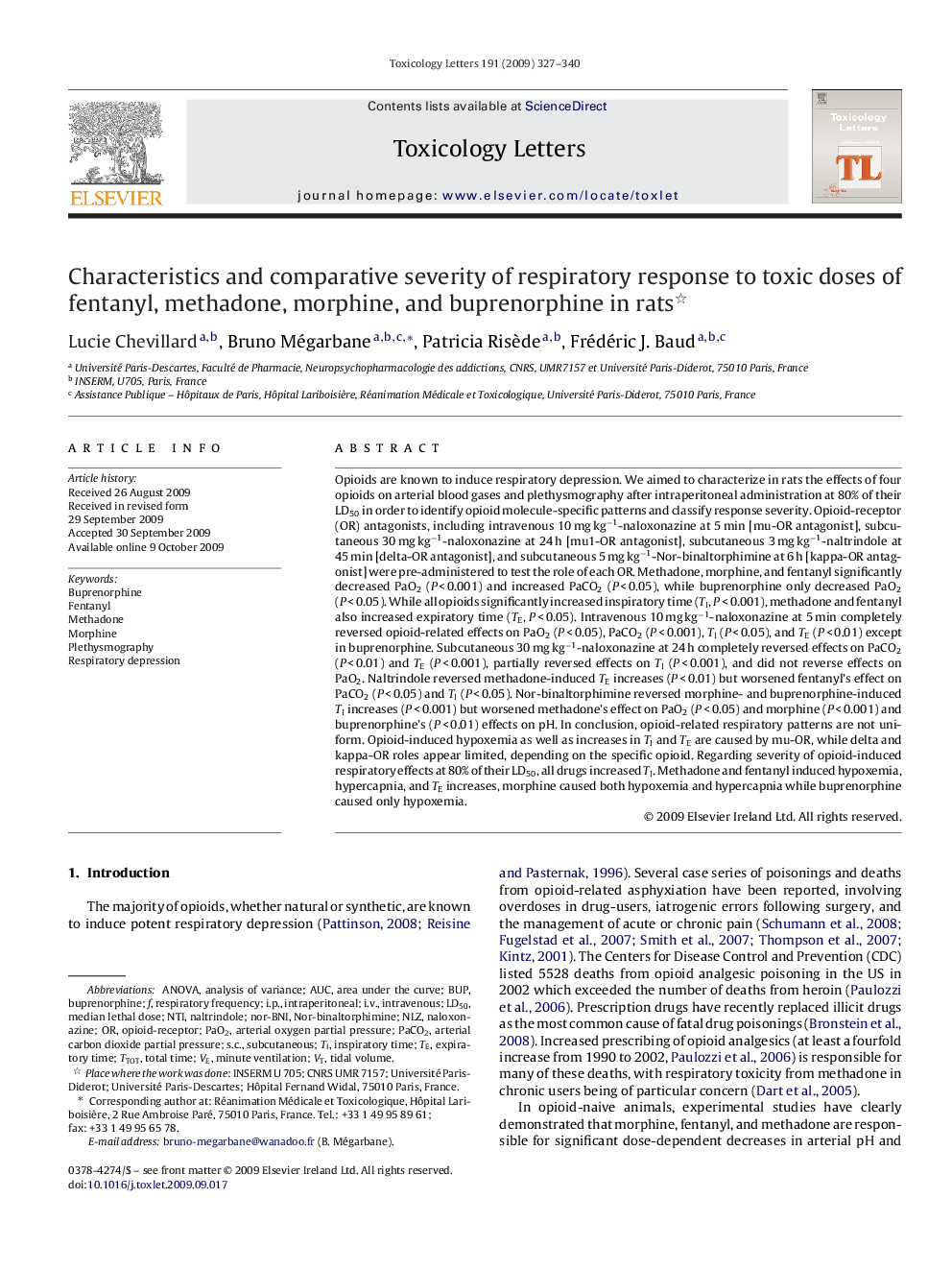| Article ID | Journal | Published Year | Pages | File Type |
|---|---|---|---|---|
| 5860937 | Toxicology Letters | 2009 | 14 Pages |
Abstract
Opioids are known to induce respiratory depression. We aimed to characterize in rats the effects of four opioids on arterial blood gases and plethysmography after intraperitoneal administration at 80% of their LD50 in order to identify opioid molecule-specific patterns and classify response severity. Opioid-receptor (OR) antagonists, including intravenous 10 mg kgâ1-naloxonazine at 5 min [mu-OR antagonist], subcutaneous 30 mg kgâ1-naloxonazine at 24 h [mu1-OR antagonist], subcutaneous 3 mg kgâ1-naltrindole at 45 min [delta-OR antagonist], and subcutaneous 5 mg kgâ1-Nor-binaltorphimine at 6 h [kappa-OR antagonist] were pre-administered to test the role of each OR. Methadone, morphine, and fentanyl significantly decreased PaO2 (P < 0.001) and increased PaCO2 (P < 0.05), while buprenorphine only decreased PaO2 (P < 0.05). While all opioids significantly increased inspiratory time (TI, P < 0.001), methadone and fentanyl also increased expiratory time (TE, P < 0.05). Intravenous 10 mg kgâ1-naloxonazine at 5 min completely reversed opioid-related effects on PaO2 (P < 0.05), PaCO2 (P < 0.001), TI (P < 0.05), and TE (P < 0.01) except in buprenorphine. Subcutaneous 30 mg kgâ1-naloxonazine at 24 h completely reversed effects on PaCO2 (P < 0.01) and TE (P < 0.001), partially reversed effects on TI (P < 0.001), and did not reverse effects on PaO2. Naltrindole reversed methadone-induced TE increases (P < 0.01) but worsened fentanyl's effect on PaCO2 (P < 0.05) and TI (P < 0.05). Nor-binaltorphimine reversed morphine- and buprenorphine-induced TI increases (P < 0.001) but worsened methadone's effect on PaO2 (P < 0.05) and morphine (P < 0.001) and buprenorphine's (P < 0.01) effects on pH. In conclusion, opioid-related respiratory patterns are not uniform. Opioid-induced hypoxemia as well as increases in TI and TE are caused by mu-OR, while delta and kappa-OR roles appear limited, depending on the specific opioid. Regarding severity of opioid-induced respiratory effects at 80% of their LD50, all drugs increased TI. Methadone and fentanyl induced hypoxemia, hypercapnia, and TE increases, morphine caused both hypoxemia and hypercapnia while buprenorphine caused only hypoxemia.
Keywords
i.v.opioid-receptorarterial oxygen partial pressureTTOTNTIBUPPaO2s.c.PaCO2LD50i.p.TV, Tidal volumeAUCNaltrindolebuprenorphineanalysis of varianceANOVAminute ventilationintraperitonealIntravenousRespiratory depressioninspiratory timeexpiratory timesubcutaneousrespiratory frequencyFentanylMethadonearea under the curvemorphinemedian lethal doseNaloxonazineNor-BNINor-binaltorphiminePlethysmography
Related Topics
Life Sciences
Environmental Science
Health, Toxicology and Mutagenesis
Authors
Lucie Chevillard, Bruno Mégarbane, Patricia Risède, Frédéric J. Baud,
